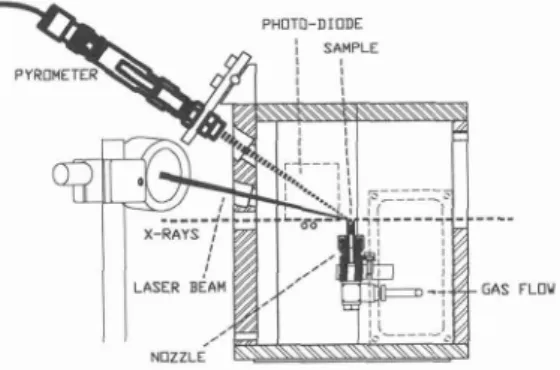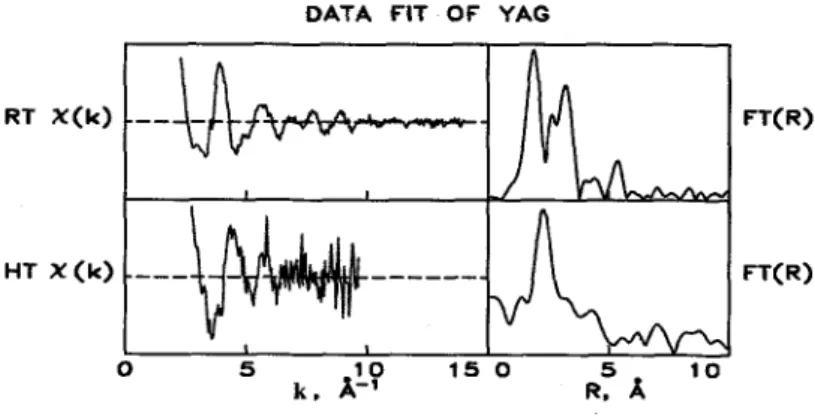HAL Id: jpa-00255294
https://hal.archives-ouvertes.fr/jpa-00255294
Submitted on 1 Jan 1997
HAL is a multi-disciplinary open access
archive for the deposit and dissemination of
sci-entific research documents, whether they are
pub-lished or not. The documents may come from
teaching and research institutions in France or
abroad, or from public or private research centers.
L’archive ouverte pluridisciplinaire HAL, est
destinée au dépôt et à la diffusion de documents
scientifiques de niveau recherche, publiés ou non,
émanant des établissements d’enseignement et de
recherche français ou étrangers, des laboratoires
publics ou privés.
Study of Crystallisation of Yttrium Garnets Y3R5O12
(R = Al, Ga) by High Temperature EXAFS
X. Launay, C. Landron, J. Coutures, Dominique Bazin
To cite this version:
X. Launay, C. Landron, J. Coutures, Dominique Bazin. Study of Crystallisation of Yttrium Garnets
Y3R5O12 (R = Al, Ga) by High Temperature EXAFS. Journal de Physique IV Proceedings, EDP
Sciences, 1997, 7 (C2), pp.C2-1255-C2-1256. �10.1051/jp4:19972220�. �jpa-00255294�
.
I
PHYS IVFRANCE
7 (1 997)
Colloque C2, Supplkment au Journal de Physique
I11 d'avril 1997
Study of Crystallisation of Yttrium Garnets
Y3&Ol2 (R
=
Al, Ga) by High
Temperature EXAFS
X. Launay, C. Landron,
J.P.
Coutures and D. Bazin*
Centre de Recherche sur la Physique des Hautes Tempbratures, 45071 Orle'ans cedex
2,
France
*LURE,
Centre Universitaire Paris Sud
91405 Orsay, France
Abstract. In this paper, we present a new high temperature EXAFS device using a laser heating system and aerodynamic levitation for experiments up to 2300°C. We report here the first spectra of Y K-edge for YAG at room temperature and in the liquid.
Refractory oxide liquids form a wide range of technologically important materials. Knowledge of the structure at these high temperatures is necessary for an understanding of their physical properties. In the aim to extend the applications of the X-ray absorption fine structure, we t i l l present an original experimental device different from that used by Crozier et al [I] : a levitation cell for radiation experiments at very high temperature. We have develop a high temperature EXAFS device, this technique using radiation synchrotron associated to a laser C 0 2 allows to study liquid state (above fusion temperature) and to reach temperature up to 2500°C. In the first part, we present the experimental device and in a second the first spectra with this containerless sample holder.
2.SYNCHROTRON RADIATION AT VERY HIGH TEMPERATURE
The EXAFS experiments were performed using DCI synchrotron radiation source at LURE (ORSAY, France). The DCI storage ring operating at 300 m.4 and 1.85 GeV. The X-Ray beam was monochromatized by a double Bragg reflexion Si (3 11)
crystals. The energy resolution was estimated to be 2 eV.
2.1 Experimental device
In Figure 1 a schematics of the analysis setup is shown. An aerodynamic levitator allows the spheric sample to float from any contact especially at high temperature.
.----
- G A S FLOW
Figure 1 : Levitation cell for high temperature EXAFS experiments
C2-1256
JOURNAL
DE
PHYSIQUE IV
The detector is adjusted in order to obtain optimum fluorescence emitted by the sample. We used a Si photodiode of 300pn
thickness to obtain the higher detection efficiency.
This high temperature device presents several advantages : the liquid is neither physically nor chemically perturbed by the container, suppression of heterogeneous nucleation during cooling, suppression of the pollution of the liquid by the container.
2.2.Results and discussion
Rare earth aluminium garnet Ln3AI,012 (Ln = Y) single crystals have been great interest in solid state electronic systems. Temperature dependent X-ray Absorption Spectroscopy offers a great opportunity for structure analysis of YAG processing by sol-gel method [2]. YAG powders were prepared by an organic gel-assisted citrate process [3] A representative plot of the EXAFS interference function ~ ( k ) is shown Fig 2.
DATA FIT OF YAG
Figure 2 : Spectra of Y K-edge for YAG at room temperature (RT) and 2200°C (HT)
The dominant low frequency oscillation in ~ ( k ) at high temperature is determined by interference of the photoelectrons for the first shell coordination in comparison with the room temperature where appears the second shell.
A comparison of the Fourier transform at room temperature and in the liquid phase indicates some structural changes with the temperature. Structural parameters obtained by least squares fitting the EXAFS spectra for the coordination shell around yttrium ions. By the fit, the distance yttrium-oxygen is found to be lower for the room temperature: d(Y-0) = 0.233 nm and 0.242 nrn at room temperature d(Y-0) = 0.295 nm 1 0.3 19 nm at 2200°C. The interpretation of the increase of this distance is based on the fact that the temperature brings a distortion of the dodecahedron in the liquid phase.
We have developed a new X-ray analysis cell for synchrotron radiation experiments at high temperature. This study illustrates the possibilities of this new device to study solid state mechanisms such as phase transitions and knowledge of liquid phase. Great improvements in signal -to-noise ratio can be expected with our new cell and for the synchrotron of the third generation.
Acknowlegments
We gratefully acknowledge the staff au LURE for assistance during dedicated runs.
[I] Crozier E.D, Lyttle F.W and Sayers D.E. Stem E.A., Can.J.Chern Volume 55 (1977) 1968-1974. [2] Koningsberger D.C.,X-Ray Absorption, Willey Interscience Publ., New Yotk (1988). [3] Douy A. and Odier P., Mat.Res.Bull., Volume 24 (1989) 1 1 19.

